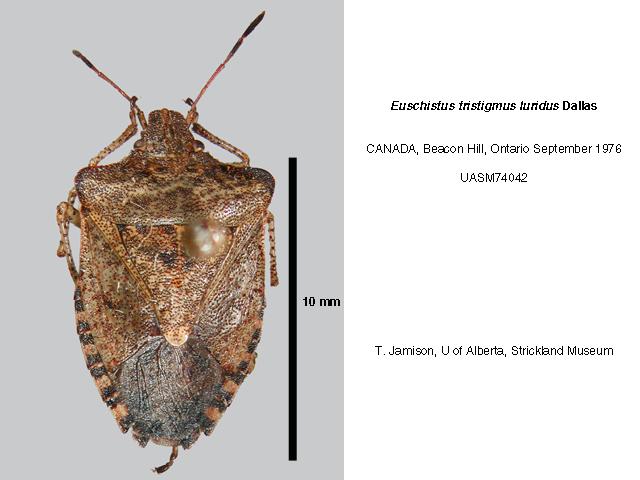Species Details
Euschistus tristigmus luridus
University of Alberta E.H. Strickland Entomological Museum Read more about this collection »
Common NameDusky Stink Bug
SeasonalityJune or July to late September.
IdentificationBody form is elongate, oval and usually smaller than the rest of the genus. Dorsal surface grayish in colour and covered evenly with dark brownish-gray punctures. The apical (end) fifth of the pronotum is a brighter yellow colour with much less puncture marks, usually smooth. The humeral angles of the pronotum are quite broad and rounded with the concavity on the anterior edge pronounced. The apical half of antennal segment four and all of segment five are dark brown to black in colour. Length 10-12 mm and width 7-7.5 mm (Blatchley 1926). This subspecies, as well as E. t. tristigmus, has black spots on the middle of the abdomen (McPherson 1982).
Scientific Name
Euschistus tristigmus luridus
Common Name
Dusky Stink Bug
Habitat
Grasslands and hay fields.
Seasonality
June or July to late September.
Identification
Body form is elongate, oval and usually smaller than the rest of the genus. Dorsal surface grayish in colour and covered evenly with dark brownish-gray punctures. The apical (end) fifth of the pronotum is a brighter…
Body form is elongate, oval and usually smaller than the rest of the genus. Dorsal surface grayish in colour and covered evenly with dark brownish-gray punctures. The apical (end) fifth of the pronotum is a brighter yellow colour with much less puncture marks, usually smooth. The humeral angles of the pronotum are quite broad and rounded with the concavity on the anterior edge pronounced. The apical half of antennal segment four and all of segment five are dark brown to black in colour. Length 10-12 mm and width 7-7.5 mm (Blatchley 1926). This subspecies, as well as E. t. tristigmus, has black spots on the middle of the abdomen (McPherson 1982).
Life History
This subspecies overwinters as adults in leaf and plant litter (McPherson 1982).
Conservation
Not at risk.
Diet Info
This subspecies has been found on the following host plants; raspberry, sumac, Salix (willow), hazelnut, scrub-oak, meadow-sweet, marsh grasses, wild rose, button-bush, tomatoe, pear, poplar, yellow birch, pine,…
This subspecies has been found on the following host plants; raspberry, sumac, Salix (willow), hazelnut, scrub-oak, meadow-sweet, marsh grasses, wild rose, button-bush, tomatoe, pear, poplar, yellow birch, pine, goldenrod, elder, mullein, alfalfa and hollyhock. It also may feed on the eyespotted bud moth larvae in the lab (McPherson 1982).
Range
Euschistus t. luridus is known mostly north of 41°N latitude coast to coast across southern Canada and the northern United States (McPherson 1982).
References
Author
Blatchley, W.S.
Title
Heteroptera or true bugs of Eastern North America with especial reference to the faunas of Indiana and Florida.
Publication Date
1926
Pages
1116 pp
Author
McPherson, J. E.
Title
The Pentatomoidea (Hemiptera) of Northeastern North America, with emphasis on the fauna of Illinois
Publication Date
1982
Specimen Information
There is 1 specimen of this Species.
UASM74042 - Euschistus tristigmus luridus
University of Alberta E.H. Strickland Entomological Museum
Place CollectedCanada: Ontario, Ottawa
Collected ByBaker, G.
Date Collected1976-09
